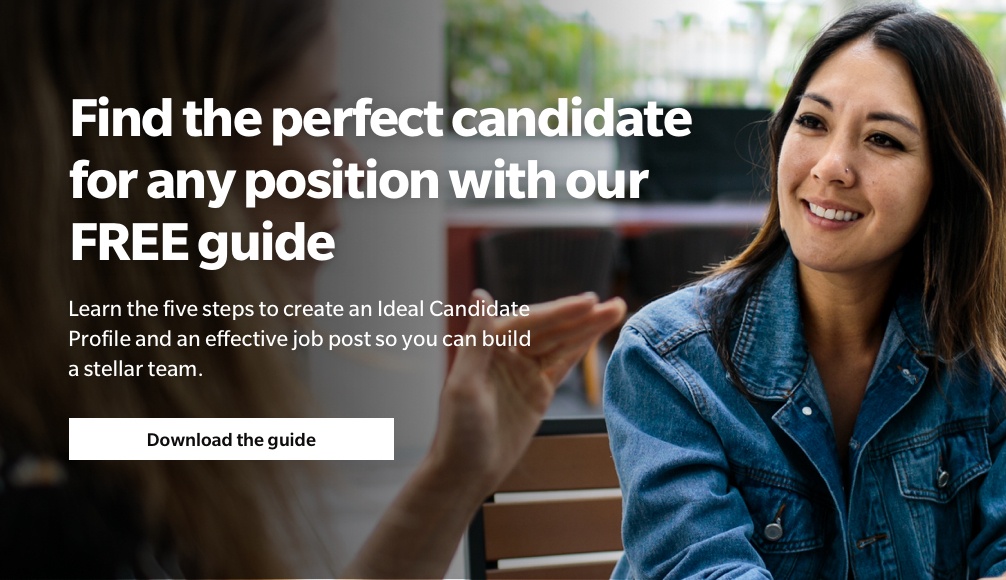Finding the right people for your business takes a thoughtful (and flexible) process. Before you even sit down to interview your first candidate, you need to figure out the specifics of the role you’re hiring for, who will fit that role, and how to find them. This is the “marketing” phase of your hiring process, and it’s how to get quality applicants in the door.
As a business leader, you know the struggle of trying to hire "A" players—too many or too few applicants for a role, a skills gap in the industry, or a turbulent job market such as we’ve experienced in the last few years. Here are two big strategies that can help.
What are the right tools for hiring?
Having a system for hiring with the right resources is like having a roadmap: You know the end point you want to reach—hiring the perfect person—and the path you have to follow to achieve that goal. The basic resources you need are:
- A contract that describes the role, including its responsibilities and expected results.
- A clear and magnetic job post.
- An HR recruitment platform that suits your business. We use JazzHR.
- A template that identifies every step of your hiring process. This could be in a file document or something more comprehensive, like an Asana project.
Having a process grounded in these assets helps you remember the small steps you took to (for example) upload a job post into your HR system, and gives you something to continuously update and improve upon.
How do you find the best candidate for a job?
1. Refine your job posting
Edit the job title to attract more of the candidates you want
We recently posted for a role with the term “associate” in the title, and quickly found that we weren’t getting candidates with the level of experience or skills that we required from our Ideal Candidate Profile. So, we revised the post slightly and replaced “associate” with “specialist”. That small change created a dramatic effect. We saw a different level of candidates applying, ones more in line with our needs for the role. Our conclusion: Titles are psychological. We needed to title the role appropriately to reach the caliber of people who possibly saw an associate position as a downward move. But such a change may come with a salary increase. Before you do something like this, ask yourself: Does this title change still align with the job role and what you're able to pay?
Create a skimmable format
People tend to skim and, honestly, most aren’t paying the kind of attention you’d like. Don’t fight against that truth by creating huge blocks of text and expect people to read them. Instead, make your sections concise and bite-sized with lots of bullets. Readability is key.
Reorder bullet points
How you order your bullets automatically sends the message of a top-down list of priorities. For a recent digital hire, we included the importance of having HubSpot experience, but we placed it well down in the list—and received no applications from candidates with that experience. Because it was critical for us, we shifted that requirement higher up in the job post, and it changed what experience we saw coming in.
Revise the job profile
Do you mean to hire a director or a VP? If you don’t know for sure, you may discover it after you post and see applicants come in. We had this experience, developing and posting for a director-level role. As resumes poured in, we saw that many candidates indeed met the requirements of a director, but still weren’t at the level that we expected. We made the choice to elevate the title—in this case, we made the role more suited to what skill gap we really needed to fill.
Be thoughtful about where you advertise
Our HR recruitment system automatically sends our job posting to preferred job sites. Be sure to post in a place where the people you want to see your post will see it—and that’s not necessarily a free site. For a digital or technology position, you may want to post on Dice. If your goal is to diversify your team, you need to make active shifts in your hiring process, one of which could be posting on sites like Diversity.com or PDN Recruits. Other great sites include Glassdoor for a large pool of candidates with more experience and education and LinkedIn if you want to have a look at a candidate's extensive experience and whether they may be culture fit.
Consider who you’re hiring and where they’re looking for jobs. Engage your marketing thought-process to make sure your message is reaching the right people.
2. Improve your screening process
We recently hired for a management-level post, and the role was open for a long period of time—in part because of the candidate market, and in part because we just weren’t finding what we wanted. For this particular role, we got over 1,200 applicants before we closed submission. We knew that we needed to set a high standard for narrowing down such a massive pool. Here's how we did that.
Cut for not following guidelines
We required a cover letter for the role, and nearly 30% percent of people didn't include that, immediately disqualifying them from our list of variable candidates. It doesn’t have to be a cover letter, but if you have a standard that you require for applying, stick with that.
Screen for skills and culture
After that first step, we then screened resumes for skills fit. Approximately 55% of all applicants didn’t match our skills or location requirements. Those two first steps brought our pool down from over 1200 to about 200!
Create a scored evaluation form
With the remaining resumes, we had to create an internal screening form with specific parameters around our priorities. So we set standards that could be scored and said, “Okay, on a scale of 0-100, we’ll consider any candidate who ranks 70 or higher.” An applicant that met the basic parameters of the job post moved into this evaluation phase, which created an objective and streamlined process.
To create your own evaluation form, ask yourself:
- What specifically am I looking for?
- What are 5-7 standards that we can rank for, such as years of experience, an educational degree or culture fit?
- Did the candidate's application show that they've familiarized themselves with our company?
If you get this far and still need to narrow down your pool to 5-10 interviewees, create a custom screening step that suits the role. Maybe that’s a portfolio review, a hiring seminar or a pre-recorded video screen. To find the right fit for the position and your company, you need to get a good sense of who each candidate is as they enter the interview phase.
If you have more questions about how to reach the perfect employees, download our free guide The Five Steps to Creating the Perfect Job Post or talk with a coach.




Comments